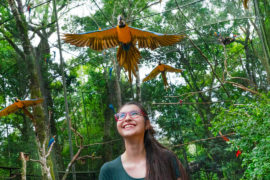When getting closer to Foz do Iguacu, prying eyes from the plane window catch sight of the Iguaçu River forming a meander line throughout the green Atlantic Forest of the National Park. With a bit of luck, the landing route goes by the Iguacu Falls and it is possible to have a small showing of what is about to come.
In my case, this wonderful view is a beautiful way to feel welcome at home! Born and raised in Foz do Iguacu, I confess I have already lost the counts on how many times I have visited the Falls. It doesn’t mattter… just like the tourists thar visit it for the first time, I always crane the neck to get a glimpse at all this beauty.
Besides visiting the place sice I was a child, I also used some help of friends to create this Complete Guide of the Iguacu Falls. So keep on reading to get information about:
- Visit and tours at Iguacu Falls
- Practical tips to enjoy the experience at most
- Curiosities about the National Park
National Park and Iguacu Falls
The Iguacu Falls really leaves anyone with the jaw-dropping!
There are 275 falls, spread on almost 3 Km along the imponent Iguaçu River. It’s an immersion experience, with spectacular views from the footbridge and getting very close to the falls. Because of its “V” format, you can find yourself surrounded by 260º of falls while making the tour.
Between the falls, the Devil’s Throat (in Portuguese: Garganta do Diabo; in Spanish: Garganta del Diablo) is the one that stands out. It is the last waterfall, with the U shape, 82 meters high, 150 meters width and 70 meters of lenth. It’s also the border point between Argentina and Brazil.
The National Park, created in 1939, keeps a large Atlantic forest that’s rich in Brazilian fauna including threat of extinction species: like jaguar, puma, broad-snouted caiman crocodile, vinaceous-breasted amazon parrot, harpy eagle, and others.
All of this added to the beauty of the Falls, made the Iguacu National Park to be the first Conservation Unit of Brazil that was stablished as the World Natural Heritage Site by Unesco, in 1986.
Iguacu Falls Itinerary
I recommend that you visit to the Brazilian side of the Waterfalls on the first day of the trip. The contact with all the cascades gives such a good energy, that will change the vibe of the whole trip!
Day 1:
You can go to the Bird’s Park, wich is located next to the National Park. At 9 o’clock the birds are fed, so they are more active in the morning and it’s a good time to visit.
Then, walk until the Visitor’s Center of the Iguacu National Park. If it’s lunchtime already, take the bus of the Park until the last stop, where there is a restaurant, a big snack bar or a good place to have a picnic.
Walk or take the bus to the first belvedere and then your visit of the Falls from there.
When you finish the visit, you can still make the Macuco Safari tour, that will get you soaking wet, so it’s best leave it to the end.
Day 2:
After having a bigger look-out from Brazil, on the next day visit The Iguazu National Park in Argentina. Two-thirds of the cascades are there and the footbridges are quite near to the falls, so you can energy from closer – and also get wet.
Tours
Besides enjoying the view from the footbridges and belvederes, there are options of tours inside or near de Iguaçu National Park, that can be hired separately:
1. Macuco Safari
Tour with an inflatable boat through the Iguaçu River, that gets very close to the cascades of the Falls. So close that it’s normal that everyone end up wet! The first part is done with a cart pulled by an electric car through the Atlantic Forest, then there’s a 600-meter walk to get to the boarding place. The boats are big and, can handle until 25 people and leaves every 15 minutes.
Local tip! If you intend to visit the Iguazu Falls in Argentina, the tour with the inflatable boat is cheaper there, at around R$90,00 (at around US$ 30). At the Argentinian’s side there isn’t the electric car part, the walk to get to the boarding place is longer and steep, but for the people who are used to practice exercises it is just fine (and you save some money)!
2. Bike, walk or run in the National Park
The path taken by bus in the Park, that goes from the Visitor’s Center to the Iguaçu Falls, can also be trailed by bike, walking or running.
It’s around 11 km, and 3km of them with a paver track next to the main road, and the trail left are done on the shoulder. Although it’s beside the traffic of cars and buses, the trail is very beautiful, surrounded by the forest. It is possible to hear and see a lot of animals like tucanos, small monkeys and even alligators (we saw a baby alligator once, but it’s counting, right?).
To go by bike, you can take your own, rent or book a tour (Iguassu by Bike). Pay the entrance as normal and then follow the road.
3. Helicopter Tour
Panoramic flight, thats flyes over all the Iguacu Falls cascades. By the photos, it’s possible to see the helicopter gets very close and the view from this angle must be stunning.
The tour takes around 10 minutes and it isn’t necessary to book, because there are a lot of flights a day. The heliport is very near to the National Park entrance, and counts with a parking lot and snack bar.
4. Not anymore available Tours
There were even more adventure options, like rafting, tree climbing and abseiling, but the concession contract went over in June of 2014, it wasn’t renewed and other companies didn’t take part in the new competition the manage the tours, so there aren’t these options anymore.
The Luau at the Falls isn’t happening either. We heard it’s because of the lack of an authorization of ICM Bio or something like that, but we don’t know at all.
The Poço Preto Trail is still going on, but we don’t recommend here because they took the kayak part out of the tour and now it’s only on a motorized boat, so we think it isn’t worth it anymore.
Where to Eat inside the National Park
Options of places to enjoy a picnic, have a snack, lunch or dinner:
Snack Bars
There are snack bars at some points on the trail, that serves drinks and snacks. Besdides, there is a bigger snack place next to the restaurant, at the end of the tour, that also serves fast-food.
Local tip > Even at the snack bar or in the restaurant, there are tables on the deck outside, with the view to Iguaçu River. So if you have money for lunch, it’s worth it! Wanna save? Bring something and have a picnic on this place.
Porto Canoas Restaurant
At the end of the road in the National Park is Porto Canoas restaurant. With a Brazilian cousine buffet, it’s a good place to have lunch and enjoy the view of Iguaçu River. There are many tasty options for hot dishes and desserts. The fare per person goes around R$58,00 (at around US$20) and there’s a discount the local people.
Restaurants of the Falls Hotel
Inside the National Park, it’s also located the Falls Hotel (Hotel das Cataratas, in Portuguese), the only one in the Park and with a very beautiful view of the Falls. The prices for accommodation in the hotel are pretty higher, but either way you can still take time to check the restaurant and bar in there.
The Itaipu Restaurant has a roof with the view of the Falls and offers a combination of the international cousine with Brazilian ingredients. It is open only for dinner (from 7:30p.m. to 23p.m) with an a la carte menu.
The Ipê Restaurant is by the pool and is open both for lunch and dinner. At lunch time (12:30p.m. to 3p.m.) it offers à la carte dishes, but sometimes they provide a buffet service. For dinner, they serve a traditional gaúcho barbecue (prepared by the people in the south of Brazil) with a great variety of grilled meat, fish and vegetables. They also provide a buffet with vegeterian options, salad, seafood and dessert.
For those who just want to have an appetizer at the and of the day by a piano sound, a good choice is the Tarobá Bar – also located in the Falls Hotel. They serve drinks, cocktails and lighter food.
Local tip! The restaurants of the hotel are seasonal and for those who aren’t guests, the entrance is allowed from 8p.m.. It isn’t necessary to pay to get into the Park at this time, but must make the reservation in advance.
When to Go
In my opinion: always! With a lot or little water, cold, hot or raining it is always beautiful and interesting. Besides the weather is very impredictable around here, you can try to plan according to the weather in Foz do Iguaçu.
I prefer going during the week, when there are less people visiting. On long holidays and summer vacation it is crowded. So if you only have this time to enjoy, bring patience. What to Take
Basic Items:
- Sunblock
- Comfortable shoes – I like to wear sneakers, but even flip flops will do it
- Water and snack (there are options inside the Park, the prices are not a rip off, but they’re higher anyway)
Items for more comfort:
Generally on the footbridge there’s a lot of humidity and splash from the waterfalls. Besides, for those that will go on Macuco Safari Tour (inflatable boat tour), it’s indispensable taking:
- Anorak or raincoat
- Or get wet, it’s so good! In this case take a small towel / sarung to dry yourself + an extra shirt
- Waterproof camera, special protective or plastic bag to protect your photo or video camera
Tips and more Info about the Iguacu Falls
Click below to check the answers for the most frequent questions about the Falls and the Iguacu National Park: Every day, including weekend and holidays, from 9a.m. to 5p.m. “How much is the entrance?” For tourists, access the tickets fare chart (official Iguacu Falls website link)
For the people who live in the cities around, the price is different and the Comunity Pass work (official Iguacu Falls website link). The National Park accepts: debit card or cash in Brazilian Real, America Dollar, Paraguaian Guarani, Argentinian Peso and European Euro.
So even if you have foreign currency, there’s no need to worry about changing money before going. It is also possible to withdraw money in the 24h eletronic machine at the Visitor’s Center. The Iguacu National Park is in Foz do Iguacu – PR, 18 km from the city center and only 5 km from the airport. So it’s easy to get there:
For those that go by car, there are options to park in the Park car park, that charges a flat rate, and others parking lots nearby, that are usually cheaper.
To go by taxi, the trip is around R$50,00 from the center of Foz do Iguaçu.
To go by bus, take the 120 line – Parque Nacional do Iguaçu/Aeroporto no TTU – ALA 02, that stops on:
- Tarobá Street
- Engenheiro Rebouças Street
- Juscelino Kubistchek Avenue
- Jorge Schimmelpfeng Avenue
- Cataratas Avenue
- BR 469
- Airport
- BR469
- Iguacu National Park (get off at the last stop)
There’s no need to worry about it, because the big part of the trail is on the shade. I like to go at around 10 o’clock in the morning, because aside from the light be very good to take photos, at this time it isn’t very hot in the summer and it’s less foggy in the winter. Between getting to the entrance of the park, take the bus, do the walking and returning, it takes around 3 hours for a regular visit. For who is taking another payed tours too, it’s going to take longer. There’s a big visitor center, bus to transportations inside the park, restaurant, snack bars and even a hotel (with a higher charge, but privilege location)
The National Park is managed by Cataratas S.A. company, that have the concession for many other parks, like in Fernando de Noronha and Corcovado in Rio de Janeiro. No, the trail is only 1.200 meters long and the going to the Falls is all the way down. Although there are many steps, it’s ok for children and active people older than 60 years old can do it. To go back, it’s possible to take the same trail or take the lift.

Yes, but not all the places!
The parking lot has reserved spots, ramp to get to the visitor’s center, accessible buses and adapted bathrooms. Big part of the trail is not accessible, because there are steps. So it’s necessary to go on the bus until the last stop. From there it is possible to go to the footwalks that leads to most beautiful view of the Brazilian Falls. So I think it’s worth it!
Local tip > If you are thinking of going with a guide or group, tell them about this point, because if they are going to do all the trail, you will need to get apart from them.
Curiosities about the Iguacu Falls
One of the New 7 Natural Wonders in the World
The Iguacu Falls is one of the New Wonders of the Nature, title given by the New Seven Wonder Foundation, in 2012. The competition was fierce, starting in 2007 with 440 attraction of 200 countries and territories taking part in. After two stages, that involved popular voting and the selection of specialists,the Falls conquered a place between the 28 finalists.
The other wonders are: Baia Ha Long – Vietnam, Jeju-do – South Korea, Komodo – Indonesia, Subterranean River of Porto Princesa – Filipines, Table Mountain – South Africa.
Tribute to Santos Dumont
He wasn’t only the “father” of aviation, but also of the National Park. Santos Dumont had essential role on the expropriation of lands where the Iguacu Falls is placed, wich at that time belonged to the Uruguayan farmer Jesus Val.
He visited the local in 1946, when he was 43 years old. Using his influence, he succeded getting the government of Paraná Province to expropriate the lands, declaring of public utility. More than 20 years later, in 1939, the Federal Government created the Iguacu National Park.
The statue, therefore, is a tribute to him and can be visited at the end of the tour, near the final stop of the bus and restaurant.
X-Games
In 2013, the X-Games happened for the first time in South America and the city of Foz do Iguaçu was chosen to be the headquarter. The most part of the competitions took place at Infraero Park, but there were vertical skate try-outs with the falls on the background. It was amazing!
Have a good visit at the unforgettable Iguacu Falls!





Comentários estão fechados.